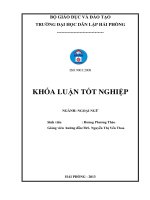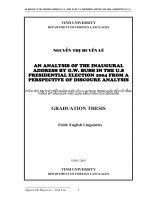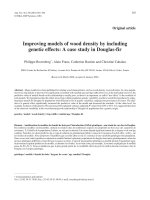An analysis of nouns formed by suffixes in english a case study of the textbook solutions pre intermedite
Bạn đang xem bản rút gọn của tài liệu. Xem và tải ngay bản đầy đủ của tài liệu tại đây (2.07 MB, 63 trang )
BỘ GIÁO DỤC VÀ ĐÀO TẠO
TRƯỜNG ĐẠI HỌC DÂN LẬP HẢI PHỊNG
-------------------------------
ISO 9001:2008
KHĨA LUẬN TỐT NGHIỆP
NGÀNH:
Sinh viên
Giảng viên hướng dẫ
HẢI PHÒNG - 2013
BỘ GIÁO DỤC VÀ ĐÀO TẠO
TRƯỜNG ĐẠI HỌC DÂN LẬP HẢI PHÒNG
-----------------------------------
AN ANALYSIS OF NOUNS FORMED BY SUFFIXES
IN ENGLISH -A CASE STUDY OF THE TEXTBOOK
“SOLUTIONS – PRE-INTERMEDIATE”
KHÓA LUẬN TỐT NGHIỆP ĐẠI HỌC HỆ CHÍNH QUY
NGÀNH:
Sinh viên
:
Lớp
: NA1301
Giảng viên hướng dẫn:
HẢI PHÒNG - 2013
BỘ GIÁO DỤC VÀ ĐÀO TẠO
TRƯỜNG ĐẠI HỌC DÂN LẬP HẢI PHÒNG
--------------------------------------
NHIỆM VỤ ĐỀ TÀI TỐT NGHIỆP
Sinh viên: ............................................................Mã SV:........................
Lớp: ..........................Ngành:....................................................................
Tên đề tài: .................................................................................................
.................................................................................................
.................................................................................................
.................................................................................................
NHIỆM VỤ ĐỀ TÀI
1. Nội dung và các yêu cầu cần giải quyết trong nhiệm vụ đề tài tốt
nghiệp ( về lý luận, thực tiễn, các số liệu cần tính toán và các bản vẽ).
……………………………………………………………………………..
……………………………………………………………………………..
……………………………………………………………………………..
……………………………………………………………………………..
……………………………………………………………………………..
……………………………………………………………………………..
……………………………………………………………………………..
……………………………………………………………………………..
2. Các số liệu cần thiết để thiết kế, tính tốn.
……………………………………………………………………………..
……………………………………………………………………………..
……………………………………………………………………………..
……………………………………………………………………………..
……………………………………………………………………………..
……………………………………………………………………………..
……………………………………………………………………………..
……………………………………………………………………………..
……………………………………………………………………………..
3. Địa điểm thực tập tốt nghiệp.
……………………………………………………………………………..
……………………………………………………………………………..
……………………………………………………………………………..
CÁN BỘ HƯỚNG DẪN ĐỀ TÀI TỐT NGHIỆP
Người hướng dẫn thứ nhất:
Họ và tên:.............................................................................................
Học hàm, học vị:...................................................................................
Cơ quan công tác:.................................................................................
Nội dung hướng dẫn:............................................................................
Người hướng dẫn thứ hai:
Họ và tên:.............................................................................................
Học hàm, học vị:...................................................................................
Cơ quan công tác:.................................................................................
Nội dung hướng dẫn:............................................................................
Đề tài tốt nghiệp được giao ngày 25 tháng 03 năm 2013
Yêu cầu phải hoàn thành xong trước ngày 29 tháng 06 năm 2013
Đã nhận nhiệm vụ ĐTTN
Đã giao nhiệm vụ ĐTTN
Người hướng dẫn
Sinh viên
Hải Phòng, ngày ...... tháng........năm 2013
Hiệu trưởng
GS.TS.NGƯT Trần Hữu Nghị
PHẦN NHẬN XÉT CỦA CÁN BỘ HƯỚNG DẪN
1. Tinh thần thái độ của sinh viên trong quá trình làm đề tài tốt nghiệp:
……………………………………………………………………………..
……………………………………………………………………………..
……………………………………………………………………………..
……………………………………………………………………………..
……………………………………………………………………………..
……………………………………………………………………………..
……………………………………………………………………………..
2. Đánh giá chất lượng của khóa luận (so với nội dung yêu cầu đã đề ra
trong nhiệm vụ Đ.T. T.N trên các mặt lý luận, thực tiễn, tính tốn số liệu…):
……………………………………………………………………………..
……………………………………………………………………………..
……………………………………………………………………………..
……………………………………………………………………………..
……………………………………………………………………………..
……………………………………………………………………………..
……………………………………………………………………………..
……………………………………………………………………………..
……………………………………………………………………………..
3. Cho điểm của cán bộ hướng dẫn (ghi bằng cả số và chữ):
……………………………………………………………………………..
……………………………………………………………………………..
……………………………………………………………………………..
Hải Phòng, ngày … tháng … năm 2013
Cán bộ hướng dẫn
(Ký và ghi rõ họ tên)
NHẬN XÉT ĐÁNH GIÁ
CỦA NGƯỜI CHẤM PHẢN BIỆN ĐỀ TÀI TỐT NGHIỆP
1. Đánh giá chất lượng đề tài tốt nghiệp về các mặt thu thập và phân tích
tài liệu, số liệu ban đầu, giá trị lí luận và thực tiễn của đề tài.
.................................................................................................................................
.................................................................................................................................
.................................................................................................................................
.................................................................................................................................
.................................................................................................................................
.................................................................................................................................
.................................................................................................................................
.................................................................................................................................
.................................................................................................................................
2. Cho điểm của người chấm phản biện : ………………………..
(Điểm ghi bằng số và chữ)
Ngày.......... tháng......... năm 2013
Người chấm phản biện
ACKOWLEDGEMENTS
When I wrote my graduation paper, I received much help. I was not only
sufficiently provided with documents but also got lots of experience and
guidance and help from my teachers as well as my friends.
In the first place, I would like to express my deep thanks to my supervisor
Ms. Nguyen Thi Yen Thoa, M.A – for her valuable guidance, helpful
suggestions and critical feedback throughout the research. Without her help
this paper will never be completed.
Besides, I would like to give my sincere thanks to Haiphong Private
University for providing us professional learning environment and facilities,
as well as all teachers in the Faculty of Foreign languages for giving
enthusiasm and sympathies to lift us to be the better ones as we are today.
In addition, my deep thank is also sent to my family and my friends for their
support in the period of time I was doing research and finish the process of
this paper.
At last, because of limited knowledge and time in the process of completion,
shortcomings cannot be avoided so I expect to receive helpful advice from
teachers and readers to make the paper perfect.
Student:
Hoang Phuong Thao
TABLE OF CONTENTS
Acknowledgements
PART 1: INTRODUCTION .......................................................................... 1
1. Rationale........................................................................................................ 1
2. Scope of the study ......................................................................................... 1
3. Aims of study ................................................................................................ 2
4. Methods ......................................................................................................... 2
5. Design of the study........................................................................................ 2
PART II: DEVELOPMENT .......................................................................... 4
Chapter 1: Literature Review.
1.1. Morphemes .............................................................................................. 4
1.1.1. What is a morpheme? ........................................................................... 4
1.1.2. Types of morphemes. ........................................................................... 5
1.2. Words. ...................................................................................................... 7
1.2.1. What is a word? ....................................................................................... 7
1.2.2. Types of words. ....................................................................................... 9
1.3. Noun-forming suffixes in English. .......................................................... 9
1.3.1. Suffixes forming nouns from verbs. ................................................... 10
1.3.2. Suffixes forming nouns from adjectives. ........................................... 12
1.3.3. Suffixes forming nouns from nouns. .................................................. 14
Chapter 2: Practical Background
2.1. An overview on the textbook “Solutions – pre-intermediate”. ................ 20
2.2. Common problems facing students in understanding the texts. .............. 20
2.2.1. Survey questionnaires with students at levels 3 and 4. ......................... 20
2.2.2. Findings. ................................................................................................ 21
Chapter 3: An analysis of nouns formed by suffixes in 10 selected texts
3.1. “Do goodies wear hoodies?” .. ................................................................. 27
3.2. “Surfing superstar!”. ................................................................................ 30
3.3. “Monowi. Population:1” . ........................................................................ 31
3.4. “A British Spy” ....................................................................................... 33
3.5. “Gift – giving in Britain” ......................................................................... 35
3.6. “The joy of txt” . ...................................................................................... 37
3.7. “Thanksgiving in the USA” . ................................................................... 39
3.8. “Wave power” ......................................................................................... 40
3.9. “Sasser” ................................................................................................... 42
3.10. “William Shakespeare” .......................................................................... 43
Chapter 4: Application of the study
4.1. Comments on the use of nouns formed by suffixes. ................................ 45
4.2. Some suggestions for English non-majors in reading the texts. .............. 46
PART III: CONCLUSION ........................................................................... 48
References ....................................................................................................... 49
Appendices:………………………………………………………………….50
Survey questionnaire 1…… .......................................................... ……….....50
Survey questionnaire 2…… .......................................................... ……….....52
PART 1: INTRODUCTION
1. Rationale
Nowadays, English is used in the world as the global language. There are
more and more people learning it. In the process of learning English, there are
many problems facing learners. One of those problems is associated with
affixes especially suffixes.
Firstly, English is an inflectional language in which words are formed by
affixes. For English learners, affixes especially suffixes usually cause
confusions. In order to have deep understanding and avoid confusion, suffix
researching is very necessary.
Secondly, the textbook for Haiphong Private University‟s non-majors namely
“Solutions – pre-intermediate” by Tim Falla and Paul A Davies (2007), like
any other text books includes a great number of texts using nouns formed by
suffixes. The students of English levels 3-4 usually get trouble when they use
this textbook. It is also motivating for me to fulfill this graduation paper.
Suffixes in English are an interesting topic which has attracted a large number
of language researchers and students. However, my graduation paper just
focuses on nouns formed by suffixes so it will be detailed and helpful for
English non-major at Haiphong Private University. It is the reason why this
paper is called “An analysis of nouns formed by suffixes in English – A case
study of the textbook “Solutions – pre-intermediate” has come into existence.
2. Scope of the study
Noun formation is so large and difficult that my graduation paper cannot
cover all kinds of noun formation; it only focuses on nouns formed by
suffixes especially derived nouns. The most typical suffixes used to form
nouns will be analyzed. There are 10 selected texts from the textbook
“Solutions – pre-intermediate” and I will analyze them to find problems and
give solutions to English non-majors at levels 3, 4.
1
3. Aims of study
Nouns formed by suffixes are an extremely difficult topic and it is easy to be
confused. Being aware of this fact, my graduation paper is aimed at:
- Giving a clear analysis of nouns formed by English suffixes in ten
typical texts.
- Help students avoid problems or misunderstanding about nouns formed
by suffixes in reading the texts.
- Help students have an insight into English vocabulary to be able to use
it effectively in communication.
4. Methods
In order to understand nouns formed by suffixes in English, these following
methods are used in the studying process:
- Questionnaires: Questionnaires will be given to both teachers and
students at levels 3, 4 non-majors to collect the data on their problems
and difficulties when they use the textbook “Solutions – preintermediate” to serve the study.
- Materials analysis: The author of this study will read different reference
books to find and collect needed information and analyze them to
contribute to the study.
5. Design of the study
This paper provides a clear organization consisting of three main parts, which
are: introduction, development and conclusion. There are five small parts in
Part I – Introduction namely: Rationale, Scope of the study, Aims of the
study, Methods of the study and Design of the study. Part II – Development
includes four main chapters such as Literature Review, Practical Background,
An analysis of nouns formed by suffixes in 10 selected texts and Application
of the study. In chapter 1, there are three small parts, which are
“Morphemes”, “Words and types of words” and “Noun-forming suffixes”. In
these subdivisions, some knowledge about morphemes, words, noun-forming
suffixes will be presented. Chapter 2 is “Practical background” with two small
2
parts: An overview on the textbook “Solutions - pre-intermediate” and
Common problems facing students in understanding the texts. Chapter 3 is
called “An analysis of nouns formed by suffixes in ten selected texts”, chapter
4 is called “Application of the study”. The last part is Part III - Conclusion
which summarizes the main points of the study and suggests ideas for further
study.
3
PART II: DEVELOPMENT
CHAPTER 1: LITERATURE REVIEW
1.1. Morphemes
1.1.1. What is a morpheme?
In linguistics, a morpheme is the smallest grammatical unit in a language. A
morpheme is not identical to a word, and the principal difference between the
two is that a morpheme may or may not stand alone, whereas a word, by
definition, is freestanding. Every word comprises one or more morphemes. A
morpheme may be defined in different ways:
Firstly, according to Eugene A Nida (1946: 1), “morphemes are the minimal
meaningful units which may constitute words or parts of words”.
A morpheme may be defined as the minimal linguistics sign, a grammatical
unit that is an arbitrary union of a sound and a meaning and that cannot be
further analyzed. This definition may be too simple, but it will serve our
purposes for now. Every word in every language is composed of one or more
morphemes.
Secondly, “A morpheme is the smallest meaningful unit in a language
which cannot be divided into smaller ones”.
(Le Van Su, 2003: 152)
In language, there are many units such as phonemes, morphemes, words,
phrases, clauses, sentences and texts. A phoneme is the smallest unit but it
does not have meaning so a morpheme is the smallest meaningful and it
cannot be divided without altering or destroying its meaning.
Thirdly, in the view of Hoang Tat Truong (1993: 11), “A morpheme is the
smallest meaningful unit of language that is not independent and only
occurs in speech only as a part of a word”.
Eg:
Cat: 1 morpheme “cat”.
Cats: 2 morphemes “cat” + “s”.
Teachers: 3 morphemes “teach” + “er” + “s”.
4
In short, morphemes may be defined as the minimal meaningful language
units and it cannot be divided any further into meaningful parts. A morpheme
has its sound form and meaning but unlike a word, it is not independent and
occurs in speech only as part of a word although a word may consist of only
one morpheme.
1.1.2. Types of morphemes
Basically, morphemes can be divided into two mains types: root morpheme
and affixational morpheme. To clarify the types of morpheme, let us consider
the following chart:
MORPHEME
Root
morpheme
Bound root
Free root
Affixational
morpheme
Inflectional
morpheme
Derivational
morpheme
Prefix
Suffix
a/ Root morphemes
A root morpheme (the root) is also called the lexical morpheme or simply the
root. It is the primary element of a word and conveys its lexical meaning.
Eg:
“FRIEND”: Friendship (relationship between friends).
Friendly (behaving in a kind and pleasant way because you
treat somebody as a friend).
“BOOK”: Bookworm (a person who likes reading very much).
Bookshop (a shop or a store that sells books).
5
In the examples above, we have the roots “friend, book”. The root remains
after removing all the other elements and cannot be analyzed any further.
There are two subtypes of root morphemes: free roots and bound roots.
Firstly, root morphemes are free roots because they can function
independently.
Eg:
WORK: workshop, workbook, homework, housework,…
From a word “work” (job), we have “workbook” (a book with exercises in it,
often with spaces for students to write answers in, to help them practice what
they have learnt), “homework” (a work that is given by teachers for students
to do at home), “housework” (the work involved in taking care of a home and
family such as cleaning, cooking, …).
Secondly, the other type is bound roots, very few root morphemes are bound
roots. Bound roots cannot function independently and it has to be combined
with other morphemes.
Eg:
“BIO” – (It means “life”): biography (the story of person‟s life written
by somebody else), biology (the scientific study of the life and
structure of plants and animals).
“GRAM” – (It means “written”): telegram (a message sent by telegraph
and then printed and given to somebody), grammar (the rules in a
language for changing the form of words and joining them into
sentences).
In short, most of the root morphemes in English are free ones. Free
morphemes are the forms which can stand by themselves as words and bound
morphemes are the forms which cannot stand by themselves but as part of
words.
b/ Affixational morphemes
Affixational morphemes are further divided into inflectional grammatical
morpheme and derivational morphemes.
6
The first is an inflectional grammatical morpheme. It is also called inflection
or ending and it carries the grammatical meaning of the word.
Eg:
Students, student‟s, students‟ (Noun paradigm)
Prettier, prettiest (Adjective paradigm)
Studies, studying, studied (Verb paradigm)
The second is a derivational morpheme (or lexical morpheme) which carries
both lexical and inflectional meanings of the word.
Basing on its position to the root, there are two subtypes of derivational
morphemes, as follows:
Firstly, the derivational morphemes which stand before the roots are called
prefixes.
Eg:
unlike, unhappy, unlucky,…
Secondly, the derivational morphemes which stand after the roots are called
suffixes.
Eg:
careful. Hopeful,…
1.2.
Words
1.2.1. What is a word?
The existence of a word is usually taken for granted by the speakers of a
language. It has been estimated that average speakers of a language know
from 45000 to 60000 words. The words we know form part of our linguistic
knowledge. Words appear in every phrases, sentences, paragraphs, essays,
etc. The word itself is an abstract definition. Most fluent learners of English
seem to know what a word is. They know, for example, that words are listed
in dictionaries, that they are separated in writing by spaces. But it is one thing
to identify words and another to suggest a definition that will apply to all
types of word in English. So there are many scholars to define the words and
their definitions can be expressed to satisfy and serve for the learners. For
7
example, we can consider the word as an uninterruptible unit of structure
consisting of one or more morphemes and which typical occurs in the
structure of phrases. Besides, some linguists base on semantic or phonological
criteria to define the word.
According to Hoang Tat Truong (1993:11), “A word is a dialectical unity of
form and content, independent unit of language to form a sentence by
itself”
In fact, a sentence is may be made by many words or only a word.
E.g:
He hardly said ten words all morning.
The sentence above contains 7 words. However, only one word also makes a
sentence.
E.g:
Go!
We can consider “go” is an imperative sentence. This sentence means an
order or a command for somebody to “go”.
Also, there are many other word definitions, for example:
On the view of Le Van Su, 2003: 51: “A word is the smallest linguistic unit
which can go alone in speech and writing”.
A word consists of one or more spoken sounds or their written representation
that functions as a principal carrier of meaning. Words are composed of one
or more morphemes.
According to Wikipedia, “in language, a word is the smallest element that
may be uttered in isolation with semantic or pragmatic content”. This
contrasts with a morpheme, which is the smallest unit of meaning but will not
necessarily stand on its own. A word may consist of a single morpheme (for
example: rock, red, quick, run, expect), or several (rocks, redness, quickly,
running, unexpected), whereas a morpheme may not be able to stand on its
own as a word (in the words just mentioned, these are “-s”, “-ness”, “-ly”, “ing”, “un-“, “-ed”). A complex word will typically include a root and one or
more affixes (rocks, redness, quickly, running, unexpected).Words can be put
8
together to build larger elements of language, such as phrases (a red
rock), clauses (I threw a rock), and sentences (He threw a rock too but he
missed).
Due to the limitation of time and paper, this paper cannot show all word
definitions. You can read and analyze my definitions in order to evaluate and
refer.
1.2.2. Types of words
There are many ways to classify words; the concept of a morpheme now
allows us to classify words into three types namely simple words, derived
words and compound words. The following is the chart of words.
WORD
simple
word
derived
word
compound
word
Firstly, a simple word is one that only consists of a root morpheme, for
example, boy, girl, cat, hat,….
Secondly, a derived word is one that consists of a root and one or more
derivational morphemes, for example, teacher, student, realistic,…
Lastly, a compound word is one that has at least two roots, with or without
derivational morphemes, for example, lady - killer, happy - go - lucky,…
1.3.
Noun-forming suffixes in English
A suffix is a combination of letters added at the end of a word, or word root.
Its purpose is either to form a new word or to show the function of the word.
In the part, the suffixes used to form nouns will be discussed. There are
9
several suffixes we will see now which form nouns: “-ness”, “-ment”, “-ity”,
“-ion”, “-ance”,…. All these suffixes are used with various adjectives or verbs
to form their noun counterparts. Make a note that these suffixes do not stand
alone. They have to couple with the roots to get meaning.
1.3.1. Suffixes forming nouns from verbs
Nouns are formed from verbs in many ways. Some have the same form as the
verbs while others add a suffix.
a/ The suffix “-age”
This suffix derives nouns that express an activity or its result. Nouns denote a
collective entity or quantity. Due to inherent ambiguities of certain coinages,
the meaning can be extended to include locations.
Eg:
Drain (Verb): to make sth empty or dry by removing all the liquid from it.
Drainage (Noun): the process by which water or liquid waste is drained
from an area.
b/ The suffix “-al”
It is combined with verbs to create nouns. The new noun denotes an action or
the result of an action.
Eg:
To propose (Verb): to suggest a plan or an idea … for people to think
about and decide on.
Proposal (Noun): formal suggestion or plan; the act of making a
suggestion.
c/ The suffix “-ant”
This suffix forms count nouns referring to persons or to substances involved
in biological chemical or physical process.
Eg:
To inhabit (Verb): to live in a particular place.
Inhabitant (Noun): person or an animal that lives in a particular place.
10
d/ The suffix “-ation”
The suffix “-ation” is directly attached to nouns without any intervening verb
in “-ate”. These forms where “-ation” is directly attached in scientific
discourse with words denoting chemical or other substances.
Eg:
To combine (Verb): To come together to form a single thing or group;
to join two or more things or groups together to form a single one.
Combination (Noun): two or more things joined or mixed together to
form a single unit.
e/ The suffix “-ee”
The meaning if this suffix can be rather clearly discerned. It derives nouns
denoting sentient entities that are involved in an event as non-volitional
participants.
Eg:
To employ (Verb): to give sb a job to do for payment
Employee (Noun): person who is paid to work for sb
f/ The suffix “-er” / “-or”.
It is combined with verbs to create new nouns. It denotes active or volitional
participants in an event. Furthermore, “-er” is used to create person nouns
indicating place of origin or residence.
Eg:
To sing (Verb): to make musical sounds with your voice in the form of
a song or tune.
Singer (Noun): person who sings, or whose job is singing.
To visit (Verb): to go to see a person or a place for a period of time.
Visitor (Noun): person who visits a person or place.
Cook (Verb): to prepare food by heating it, for example by boiling,
baking or frying it.
Cooker (Noun): a large piece of equipment for cooking food,
containing an oven and gas or electric rings on top.
London (Noun): the capital city of England.
11
Londoner (Noun): a person from London in England.
g/ The suffix “-ing”
The suffix “-ing” is combined with bare infinitive to make present participle.
Some present participles are used as nouns describing the action which the
verb refers.
Eg:
To read (Verb): to look at and understand the meaning of written or
printed words or symbols.
Reading (Noun): the activity of somebody who reads.
h/ The suffix “-ment”
This suffix changes a verb to a noun. A new noun denotes the execute process
or the result of that process. Verbs ending by “-ish” and “-gree” are combined
with the suffix “-ment” to create new nouns.
Eg:
To punish (Verb): to make somebody suffer because they have broken
the law or done something wrong.
Punishment (Noun): an illegal act or activity that can be punished by
law.
To agree (Verb): to have the same opinion as somebody
Agreement (Noun): promise or a contract made with somebody.
1.3.2. Suffixes forming nouns from adjectives
There are five suffixes which derive nouns from adjectives. They are “-ness”,
“-ity”, “-ist”, “-ism” and “-dom”.
a/ The suffix “-dom”
This suffix is combined with adjectives to make nouns. It denotes the
experience which the adjectives refer.
Eg:
Free (Adj): not under the control
12
Freedom (Noun): the right to do or say what you want without anyone
stopping you.
b/ The suffix “-ism”
The suffix “-ism” is formed by abstract nouns from other nouns and
adjectives. Derivatives belonging to this category denote the related concepts
state, condition, attitude and system of beliefs or theory.
Eg:
Social (Adj): connected with society and the way it is organized.
Socialism (Noun): a set of political and economic theories based on the
belief that everyone has an equal right.
c/ The suffix “-ist”
This suffix derives nouns denoting persons, mostly from nominal and
adjectival bases. All nouns in “-ism” which denote attitudes, beliefs or
theories have potential counterparts is “-ist”. The semantics of “-ist” can be
considered underspecified “person having to do with X”. With the exact
meaning of the derivative being a function of the meaning of the base and
further inferencing. These suffixes will be presented in this part respectively.
Eg:
Social (Adj): connected with society and the way it is organized.
Socialist (Noun): a person who believes in or supports socialism, a
member of a political party that believes in socialism.
d/ The suffix “-ity”
Words belonging to this morphological category are nouns denoting qualities,
states or properties. Apart from the compositional meaning just described.
Eg:
National (Adj): connected with a particular nation; shared by a whole
nation.
Nationality (Noun): the legal right of belonging to a particular nation.
f/ The suffix “-ness”
Quality noun forming “-ness” is perhaps the most productive suffix of
English. The suffix can attach to practically any adjective, and apart from
13
adjectival base words we find nouns as in “thingness”, pronouns as in “usness” and frequently phrases as in “all-or-nothing-ness”.
Eg:
Sad (Adj): unhappy or showing unhappiness
Sadness (Noun): the feeling of being sad
1.3.3. Suffixes forming nouns from nouns
On the view of Randolph Quirk and Sidney Greenbaum, the nouns forming
from nouns can be subdivided into four major groups. The first group is
occupational with three suffixes namely “-ster”, “-eer” and “er”. The second
group includes four suffixes “-let”, “-ette”, “ess” and “-y”/ “-ie” with namely
diminutive or feminine. Status and domain are the third group. It includes five
suffixes: “-hood”, “-ship”, “-dom”, “-ocracy” and “-(e)ry”. The last group
includes other suffixes such as “-ing”, “-ful”, …
a/ The suffix “-ster”
This suffix combines with some nouns to create new nouns. This new nouns
denote the person who engaged in an occupation or activity.
Eg:
A gang (Noun): an organized group of criminals.
A gangster (Noun): a member of a group of violent criminals.
b/ The suffix “-eer”
This is another person noun forming suffix, whose meaning can be
paraphrased as “person who deals in, is concerned with” as evidenced in
forms such as auctioneer, mountaineer,…
Eg:
Engine (Noun): the part of a vehicle that produces power to make the
vehicle move.
Engineer (Noun): a person whose job involves designing and building
engines, machines, roads, …
14
c/ The suffix “-er”
Nouns with suffix “-er” varied meanings. Apart from performers of actions
we find instrument nouns such as steamer, mixer, nouns denoting entities
associated with an activity such as trainer, winner. Furthermore, “-er” is
used to create person nouns indicating place of origin or residence (as in
Londoner, New Yorker).
Eg:
London (Noun): the capital city of England
Londoner (Noun): the people who live in London.
d/ The suffix “-let”
This suffix is added to count nouns to denoting the meaning: small,
unimportant.
Eg:
Pig (Noun): an animal with pink, black or brown skin, short legs, a
broad nose and a short tail which curls round itself
Piglet (Noun): a young pig
e/ The suffix “-ette”
This suffix combines with some nouns to create new nouns. This new nouns
denote the meaning: small, compact, imitation, females.
Eg:
A kitchen (Noun): a room in which meals are cooked or prepared.
A kitchenette (Noun): a small room or part of a room used as a kitchen,
for example in a flat/ apartment.
f/ The suffix “-ess”
This suffix derives a comparatively small number of mostly established nouns
referring exclusively to female humans and animals.
Eg:
Lion (Noun): a large powerful animal of the cat family that hunts in
group and lives in parts of Africa and southern Asia.
Lioness (Noun): a female lion
15









